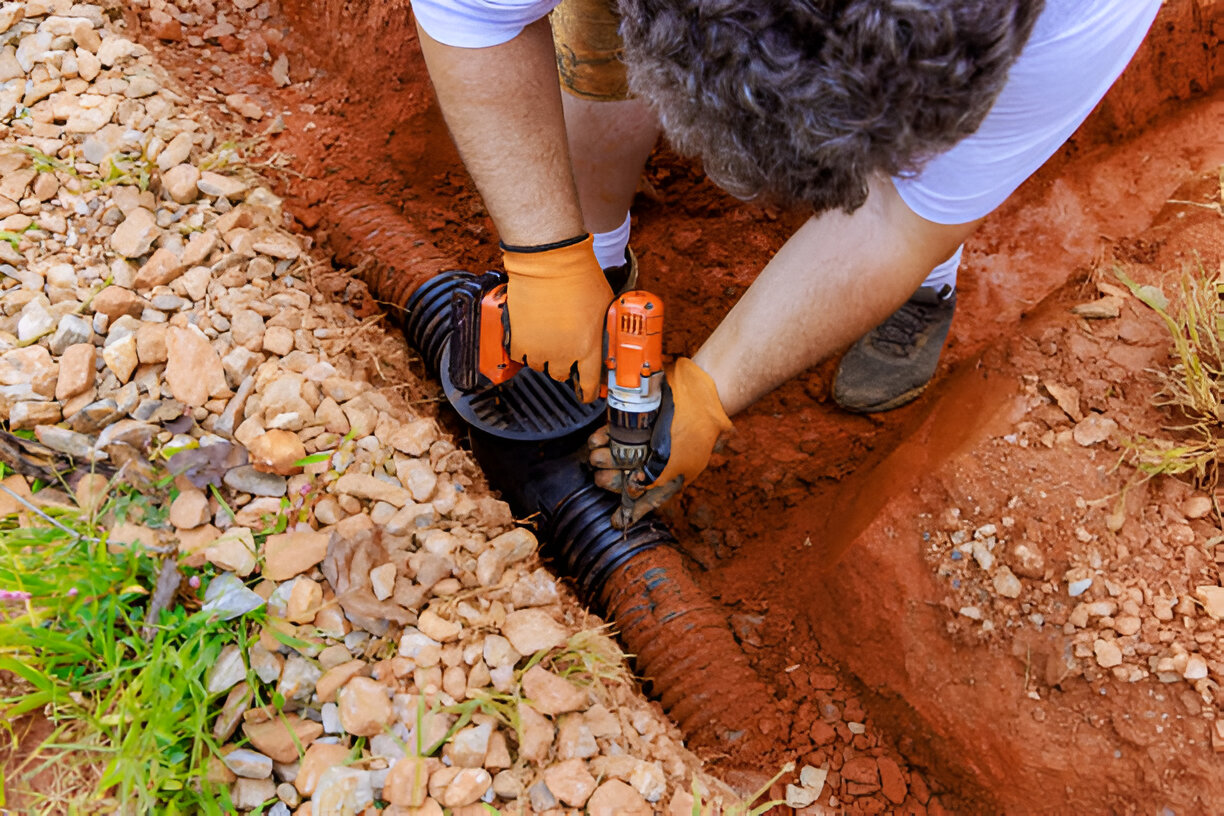Opening Hook
It started with a faint musty smell in the living room. Ahmed, a first-time homeowner in Sharjah, thought it was just the damp weather. But when a heavy rainstorm hit, his backyard turned into a mini swimming pool, and water began creeping toward his home’s foundation. The repair quotes he received from contractors were enough to make his wallet weep. That’s when he decided: If I can’t afford a big professional drainage system, I’ll build my own.
His story isn’t unique. Across the UAE and beyond, homeowners face the same dilemma—protecting their homes from water damage without spending a fortune. The good news? With the right knowledge, a bit of elbow grease, and some clever planning, you can create an effective DIY drainage system on a budget.
Understanding Why Drainage Matters
The first step in solving a problem is understanding why it exists. Poor drainage doesn’t just cause puddles—it can slowly destroy a home’s foundation, encourage mold growth, and even ruin landscaping.

Furthermore, in regions where sudden heavy rainfall is possible—even in desert climates—drainage issues can be surprisingly common. Without proper planning, water will naturally find the lowest point around your property… and sometimes that’s your basement or foundation wall.
A good drainage system moves water away from your home quickly and efficiently. And the best part? You don’t need to spend tens of thousands to make it happen.
Read More: How to Use Skylights or Light Tubes in UAE Homes
Step 1 – Assess Your Property’s Water Flow
Before buying pipes or digging trenches, take time to watch how water behaves on your property during a heavy rain.
For instance, Ahmed noticed that water pooled in one corner of his backyard before seeping toward the side of his house. By observing the water’s “path of least resistance,” he could identify exactly where to place his DIY drainage solution.
Pro Tip:
- Look for soil erosion, muddy spots, or water stains near the foundation.
- Check your gutters and downspouts—sometimes a clogged or short downspout is the root cause.
- Walk your property barefoot after a rain (yes, really). Your feet can detect soggy zones better than your eyes.
Read More: Creating a Pet-Friendly Basement Zone: A Cozy Haven for Your Furry Friends
Step 2 – Choosing the Right DIY Drainage Method
There are several budget-friendly ways to improve drainage, each suited for different situations.
1. French Drains
A French drain is essentially a gravel-filled trench with a perforated pipe that redirects water away from problem areas. It’s one of the most effective and affordable solutions.
Why It Works:
Water naturally seeps through the gravel, enters the perforated pipe, and flows downhill toward a safe discharge point.
Budget Tip:
Use recycled gravel or leftover construction stones. PVC pipes from hardware stores are far cheaper than specialized drainage pipes.
Read More: Basement Construction Mistakes Homeowners Must Avoid
2. Dry Wells
A dry well is an underground pit filled with gravel or stones where water can collect and slowly seep into the ground.
For example, Ahmed added a small dry well at the end of his French drain line, allowing excess water to disperse harmlessly into the soil rather than pooling.
Read More: Best Floor Sealants for Pakistani Cement Basements
3. Swales
A swale is a shallow, grassy ditch that channels water across your yard without causing erosion.
In contrast to underground systems, swales are visible and double as a landscaping feature. They’re great for larger properties with gentle slopes.
Read More: Gaming Setup with RGB Lighting for Basement
Step 3 – DIY Drainage Installation on a Budget
Now for the fun part—rolling up your sleeves.
Basic Steps for a French Drain (Ahmed’s Approach):
- Plan the Route – Ensure your drain slopes away from the house (a 1% slope works well—1 cm drop per meter).
- Dig the Trench – About 30 cm wide and 45–60 cm deep.
- Add Gravel Base – 5–10 cm layer of gravel at the bottom.
- Lay Perforated Pipe – Holes facing down, wrapped in landscape fabric to prevent clogging.
- Fill with Gravel – Cover the pipe with gravel, then add soil and grass on top for aesthetics.
Cost-Saving Hacks:
- Borrow digging tools from friends or community tool libraries.
- Use leftover landscaping stones instead of buying all-new gravel.
- Repurpose old garden edging as trench markers.
Read More: Basement Window Design Alternatives for Natural Light
Step 4 – Integrating Gutters and Downspouts
Even the best ground-level drainage won’t help if your roof is dumping water directly against your foundation.
For instance, Ahmed realized his downspouts ended just 30 cm from his home. He extended them with inexpensive PVC pipe so water flowed directly into his French drain.
Furthermore, adding gutter guards reduces clogging and prevents overflow during storms.
Read More: Basement Office Ideas – 11 Stylish Work From Home Spaces
Step 5 – Maintenance Is Non-Negotiable
DIY drainage is not a “set it and forget it” project. Over time, leaves, dirt, and debris can block pipes and gravel beds.

Seasonal Check-Up Tips:
- Flush the pipes with a garden hose every few months.
- Remove sediment build-up from swales or dry wells.
- Re-check the slope in case the soil has shifted.
Read More: How to Add Natural Texture to Basement Walls
The Hidden Benefits of DIY Drainage
While preventing water damage is the obvious benefit, a proper drainage system can also:
- Increase Property Value – Homebuyers appreciate visible maintenance.
- Protect Landscaping – Prevents plant roots from drowning.
- Reduce Mosquito Breeding – No stagnant water means fewer pests.
- Boost Peace of Mind – No more worrying every time dark clouds appear.
For Ahmed, the biggest win was personal satisfaction—knowing he solved the problem with his own hands for less than 15% of the contractor’s estimate.
Read More: Structural Requirements for Multi-Level Basements
Common Mistakes to Avoid
- Ignoring the Slope – Without proper grading, water will still flow toward your home.
- Using the Wrong Pipe Type – Solid pipes don’t work well underground for drainage; use perforated ones.
- Forgetting About Discharge Points – The water needs somewhere to go; don’t let it just move the problem elsewhere on your property.
- Skipping Fabric Wrapping – Without landscape fabric, gravel beds will clog with soil.
Read More: Guide to Waterproof Paint Types
A Quick Story of Success
In another case, Fatima, a homeowner in Fujairah, turned her swampy backyard into a lush garden after installing a swale and small dry well combination. What started as a DIY drainage fix ended up improving her garden’s soil moisture and saving her from expensive landscaping repairs.
Read More: Creating a Couples’ Co-working Space
Closing – A Call to Action
Water may be one of life’s greatest blessings, but when it seeps into places it doesn’t belong, it can become a homeowner’s worst nightmare. A DIY drainage system is more than a cost-saving project—it’s an investment in your home’s safety, comfort, and longevity.
If Ahmed and Fatima could transform their waterlogged yards into dry, functional spaces with basic tools and budget-friendly materials, so can you.
The next time rain clouds gather over your neighborhood, imagine watching the water flow neatly away from your home—because you took charge of your drainage.
So grab a shovel, plan your slopes, and let gravity work for you.
If you want, I can also prepare an illustrated step-by-step guide with diagrams for this same article so it’s even easier for readers to follow along. That would make it perfect for your blog or social media.
🏗️ Basement Project Calculator
Latest Post
-
Basement Ceiling Ideas Hide Ductwork Smartly
Opening Hook Imagine walking into your basement in Boise, Idaho—where the ceiling is so low that you brush your head on the joists—and noticing a sleek, well-designed backdrop above you instead of exposed ductwork and pipes. That difference, thanks to smart basement ceiling ideas, transforms a cramped, unfinished area into a welcoming space for movie…
-
أفكار رائعة لأرضيات رخيصة في دبي | أفضل ٢٠ خيارًا
تخيل زوجين شابين في شقة مريحة في مرسى دبي، يخطوان حافيي القدمين على أرضية أنيقة بلمسة خشبية. غرفة المعيشة تتلألأ بضوء مسائي خافت، والأرضية تحتها لا تزال تبدو جديدة تمامًا رغم سنوات من الاستخدام – وكل هذا بميزانية محدودة. هذه هي قوة اختيار أرضيات جميلة ورخيصة في دبي: الأناقة والتوفير في آن واحد. التركيز على…
-
Beautiful Cheap Flooring Ideas in Dubai | Top 20 Picks
Imagine a young couple in a cosy apartment in Dubai Marina, stepping barefoot onto a sleek, wood-look floor. The living room glows with soft evening light, the flooring beneath still looks brand-new despite years of use—and all this on a budget. That’s the power of choosing beautiful, cheap flooring in Dubai: style and savings in…



